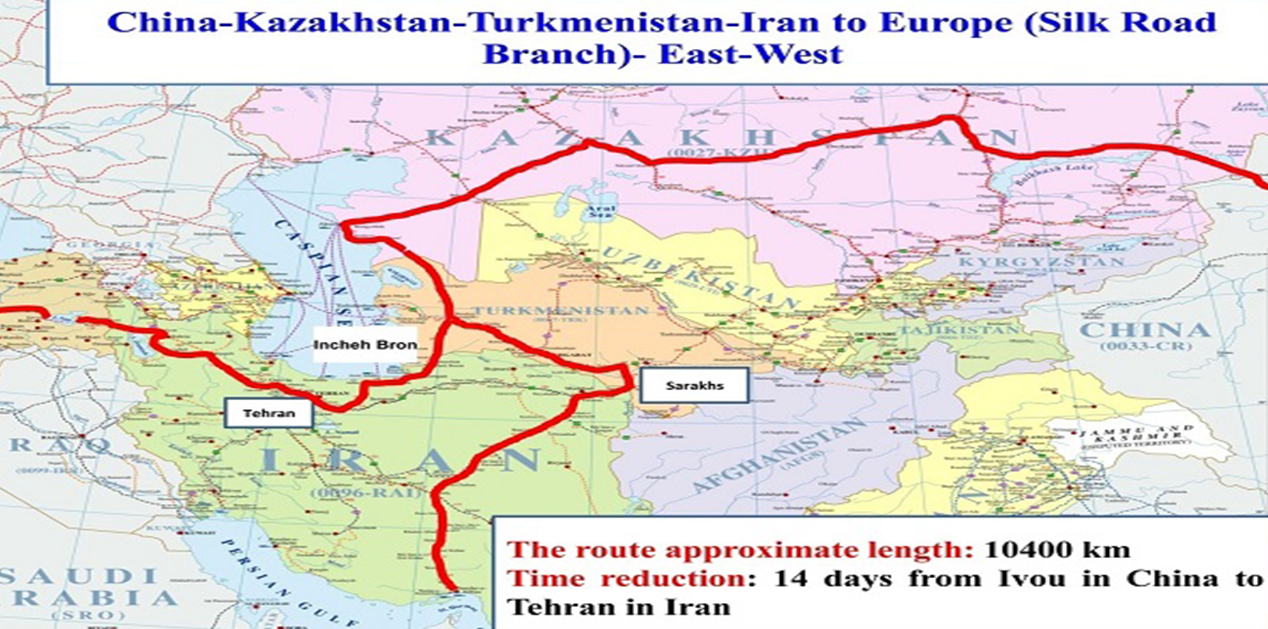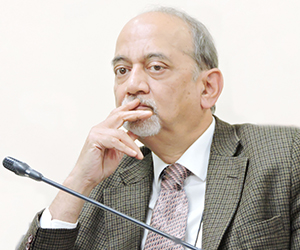Transit Corridors
Iran’s geographical location and proximity to India, make it an ideal transit hub for reaching Russia and CIS countries. The country is politically stable. It is also a fast growing economy. Its GDP is expected to grow by 5 % this year. Lifting of sanctions has made it easier to do business with that country. There are multiple axes along which International North-South Transit Corridor runs northwards from Bandar Abbas port. Amirabad port on the Caspian Sea, and Inchebarun crossing on Iran’s land border with Turkmenistan, are connected by rail-road to Bandar Abbas. Inchebarun railway crossing was inaugurated by Presidents of Kazakhstan, Turkmenistan and Iran in December 2014. Bandar Abbas is connected with Astara port on the western fringe of Iran’s Caspian sea-shore by road; the railway line has a gap between Rasht and Astara. There is rail connectivity between Bandar Abbas and Mashad, and Sarakhs,in the north east on Iran’s border with Turkmenistan. Thus considerable infra-structure already exists. In 2014, a trial run was also conducted by Federation of Freight Forwarder’s Association of India (FFFAI) under the aegis of Department of Commerce, GOI. Two containers were sent north to Astara port and Amirabad port from Bandar Abbas by road.

Iran’s Caspian Sea ports of Astara, Bandar Anzali and Amirabad are connected with the Russian port of Astarakhan. There is a railway line from Astarakhan to Moscow. This route will save an estimated 40 % in time, and 30 % in cost over the traditional route from India, which goes around Europe to St. Petersberg and Moscow. Iranian ports are similarly connected with Kazakhstan port of Aktau. Kazakhstan participated in development of Amirabad port in Iran as an outlet for its wheat exports.

According to a study done by Federation of Freight Forwarders Association of India (FFFAI), INSTC will reduce the distance from JNPT port in Mumbai to Moscow via current route from 8,700 nautical miles to 2,200 nautical miles and 3000 km (over-land). In terms of cost, this will reduce the freight cost of a 20 feet container from USD 1400 to USD 1250. The transit time will be reduced from 32 -37 days to 19 days.
INSTC will also bring enormous saving in time, and cost, for transit to CIS countries through Iran. Existing routes either go eastward to China and then loop back westward to CIS countries. The alternate route through Georgian port of Poti is also too long.
Absence of a direct route is one of the factors behindthe rather small trade volume between India and CIS countries. Russian and CIS economies together have GDP of more than 1.6 trillion dollars. Global imports of CIS countries from all sources exceed USD 67 billion. India’s share in their total import basket is a miniscule USD 362.5 million or 0.54 %. In case of Russia, while its global imports are USD 193 billion, imports from India account for only USD 1.587 billion or 0.82 %. The break-up is given in the table below:
Transit Trade
Transit trade continued during the sanctions period; there were no sanctions on the transit trade per se. Exports routed through Dubai accounted for much of the north bound traffic through Iranian ports on the Caspian. Bandar Anzali also received machinery, wood and steel from Russia.
Iran is also being used as a transit hub by member States of Economic Co-operation Organisation (ECO). This is a regional grouping of countries. This includes trade along east –west axis from Turkey to Pakistan and CIS countries. Ashgabad Agreement signed between Iran, Oman, Uzbekistan, Turkmenistan and Kazakhstan will also contribute to increasing transit trade.
However, the volume of transit trade through Iran is low. According to Port and Maritime Organisation (PMO), transit trade through Iranian ports was 7.4 % and 7.09 % of the total traffic. It should pick up as insurance, banking and shipping arrangements are normalized following lifting of sanctions.
Iran after the Sanctions
Lifting of sanctions should make it easier to do business with Iran. This will boost transit trade as well. Payment for Iranian leg of the transit, and insurance, were problems during the sanctions period. These issues can be resolved now that sanctions have been lifted. This will make it possible to have single set of documents for the entire journey from India to Russia or CIS countries. Direct payments should bring down transaction cost.
International North South Transit Corridor begins in Iran. Iran is a stable country, and has fast growing economy. According to Economist Intelligence (EIU) report of August, 2016, Iran is expected to record the fastest growth in the Middle East and North Africa from 2016 till 2020. This year, Iran’s GDP is expected to grow by 5 % despite low oil prices. The EIU report also mentions that inflation has come down from 13.7 % in 2015 to 6.8 % in June, 2016.
Iran has trade surplus as well as current account surplus. Import bill is expected to growfrom USD 52.4 billion to USD 62.1 billion. EIU report forecasts that the current account will remain in surplus, at annual average of 4.4% of GDP in 2016-20.
Recent OPEC meeting in Algiers exempted Iran, Libya and Nigeria from production cut, while agreeing to overall reduction in OPEC ceiling. The Iranian government plans to recover its share of crude production in OPEC of more than 4 million barrels a day. Its production in August stood at 3.6 million barrels per day.Iran’s oil exports have reached 2.1 million barrel per day – nearly the pre-sanction export level of 2.2 million barrels per day. While oil export constitute a major share of Iran Government’s revenue, its dependence on oil revenues is less than other countries in the region. It is a diversified economy.
Banking channels with Iran are opening up. Already, number of EU banks have resumed operations with Iran. While US dollar payments are not possible under the US sanctions, there is no sanction on payment in Euro, Japanese Yen, Swiss Franc or any other currency.
Chabahar
While Bandar Abbas port is the main port serving International North South Transit Corridor, Chabahar port could also be linked to this route, once Chabahar-Zahedan rail line is built. Zahedan is linked to Baff railway junction to the west, which is connected with Bandar Abbas in the south, and Mashad and Sarakhs in the north east of Iran.
An MOU was signed by IRCON during PM Modi’s visit to Iran for building this sector of the railway line. This included an offer of financing to the tune of USD 1.6 billion by the Indian side. The modalities of financing, however, remain to be decided. It is preferable that the entire Chabahar-Zahedan-Mashad rail corridor is completed. This will provide a direct, and shorter, access to northern Iran, than Zahedan-Baff-Mashad railway line. Mashad is already connected to Sarakh on Iran-Turkmenistan border. Once the goods reach Turkmenistan, they can move into Central Asia, which has a very well developed railway system.

One Belt One Road (OBOR)
Iran is discussing projects under ‘One Belt One Road’ initiative. China has already built a 6,000 km railway line from Eastern China to northern Iran. To the extent, OBOR contributes to building infra-structure, it will facilitate trade. There should be no conflict between OBOR and INSTC. The two could be mutually complementary. Traffic flowing along INSTC can use OBOR infra-structure and vice-versa.
Way Forward
There is a need to improve infra-structure within Iran to boost transit trade. This will involve completing Rasht-Astara railway line. This will also require upgrading Bandar Abbas – Amirabad and Bandar Abbas-Inchebarun rail corridor.
To make full use of International North-South Transit Corridor, India would also need to sign TIR (Transport Internationaux Routier) and COTIF (convention concerning international carriage by rail). These are conventions regulating road and rail traffic.
There is a need to increase shipping lines operating directly between Indian ports and Iran. Shipping Corporation of India (SCI) should start a direct shipping line. This is needed particularly for Chabahar port, which does not have any regular shipping line.
During PM Modi’s visit to Iran, financing to the tune of USD 1.6 billion was promised for Chabahar-Zahedan railway line. This commitment has to be followed with negotiation, and implementation, on the ground. Eventually, the railway line will need to be extended to Mashad also.
Trade routes bring development. Improved connectivity will benefit all countries of the region.
(The author is a Distinguished Fellow, VIF and a former Indian Ambassador to Iran)
Published Date: 24th October 2016, Image Source: http://www.torangdarya.com
(Disclaimer: The views and opinions expressed in this article are those of the author and do not necessarily reflect the official policy or position of the Vivekananda International Foundation)










Post new comment